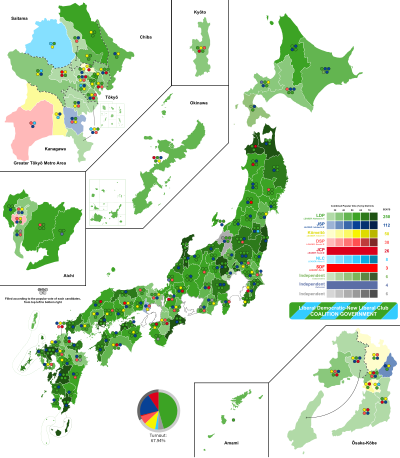
Back Eleccions generals japoneses de 1983 Catalan Shūgiin-Wahl 1983 German Elecciones generales de Japón de 1983 Spanish Élections législatives japonaises de 1983 French Elezioni parlamentari in Giappone del 1983 Italian 第37回衆議院議員総選挙 Japanese 제37회 일본 중의원 의원 총선거 Korean Wybory parlamentarne w Japonii w 1983 roku Polish 1983年日本眾議院議員總選舉 Chinese 第37屆日本眾議院議員總選舉 ZH-YUE
| |||||||||||||||||||||||||||||||||||||||||||||||||||||||||||||||||||||||||||||||||||||||||||||||||||||||||||||||||||||||
All 511 seats in the House of Representatives 256 seats needed for a majority | |||||||||||||||||||||||||||||||||||||||||||||||||||||||||||||||||||||||||||||||||||||||||||||||||||||||||||||||||||||||
|---|---|---|---|---|---|---|---|---|---|---|---|---|---|---|---|---|---|---|---|---|---|---|---|---|---|---|---|---|---|---|---|---|---|---|---|---|---|---|---|---|---|---|---|---|---|---|---|---|---|---|---|---|---|---|---|---|---|---|---|---|---|---|---|---|---|---|---|---|---|---|---|---|---|---|---|---|---|---|---|---|---|---|---|---|---|---|---|---|---|---|---|---|---|---|---|---|---|---|---|---|---|---|---|---|---|---|---|---|---|---|---|---|---|---|---|---|---|---|---|
| Turnout | 67.94% ( | ||||||||||||||||||||||||||||||||||||||||||||||||||||||||||||||||||||||||||||||||||||||||||||||||||||||||||||||||||||||
| |||||||||||||||||||||||||||||||||||||||||||||||||||||||||||||||||||||||||||||||||||||||||||||||||||||||||||||||||||||||
 Districts shaded according to winners' vote strength | |||||||||||||||||||||||||||||||||||||||||||||||||||||||||||||||||||||||||||||||||||||||||||||||||||||||||||||||||||||||
| |||||||||||||||||||||||||||||||||||||||||||||||||||||||||||||||||||||||||||||||||||||||||||||||||||||||||||||||||||||||
| This article is part of a series on |
 |
|---|
|
|
General elections were held in Japan on 18 December 1983 to elect the 511 members of the House of Representatives. The voter turnout was 67.94%, the lowest it had ever been in post-war history up to that point, and a low which would not be surpassed until ten years later.
Contrary to pre-election polls by national daily papers which projected a comfortable majority for the LDP, the latter party lost 34 seats compared to the previous election, falling six seats short of the 256 needed for majority control. As a result, the major conservative party was forced to form a majority coalition government for the first time since 1948.[1] In order to do so, the LDP formed a coalition with the New Liberal Club, a move which JSP leader Masashi Ishibashi called a "betrayal of the electorate."[2]
It is likely that the LDP's losses resulted in great part due to running too many candidates and thus falling prey to the spoiler effect. The biggest winner among the opposition was Kōmeitō, which saw an increase in terms of both seats as well as the popular vote that exceeded all of the other parties. This election also saw considerable tactical voting cooperation between the Japan Socialist Party, Komeito, Socialist Democratic Federation, and Democratic Socialist Party in various combinations, which resulted in varying levels of success for the opposition, but primarily for Komeito's outcome.[1]
- ^ a b Baerwald, Hans H. (1984). "Japan's December 1983 House of Representatives Election: The Return of Coalition Politics". Asian Survey. 24 (3): 265–278. doi:10.2307/2644066. ISSN 0004-4687. JSTOR 2644066.
- ^ "ELECCIONS". Dossier-CIDOB (2): 6–8. 1983. ISSN 1132-6093. JSTOR 40591549.





